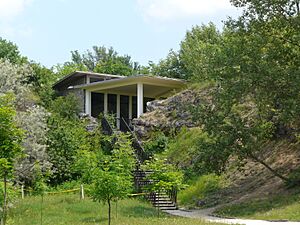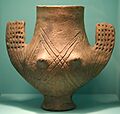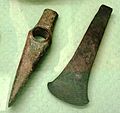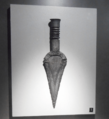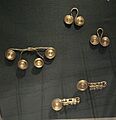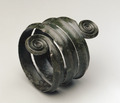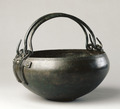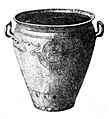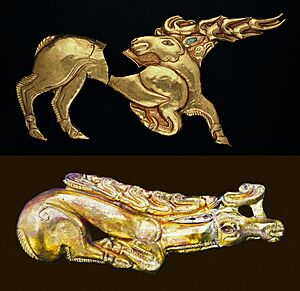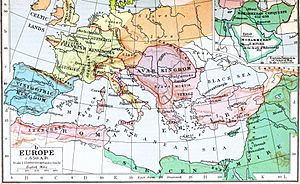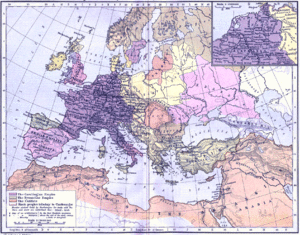History of Hungary before the Hungarian conquest facts for kids
The history of Hungary before the Hungarian conquest tells the story of the land that would become Hungary, long before the Hungarian tribes arrived in the 800s.
The very first signs of humans here belong to an ancient human species called Homo heidelbergensis. After a long gap, Neanderthals lived in the area about 100,000 years ago. Modern humans, like us, came to the Carpathian Basin before 30,000 BC. They were part of a group known as the Aurignacian culture. Most of the Stone Age after this time doesn't have much archaeological evidence. However, the Linear Pottery culture was very important. They were like "garden people" who brought farming to the Carpathian Basin.
During the Copper and Bronze Ages, three main groups lived here: the Baden, Makó, and Ottomány cultures. A big step forward was learning how to work with metals. The Baden culture also started burning their dead (cremation) and traded with places far away, like the Baltic Sea and Iran. Later in the Bronze Age, things became chaotic. New groups of nomads, possibly from ancient Iran, moved into the area during the Iron Age. Over time, many different groups came to the Carpathian Basin. The Hallstatt Celts from the west were very important around 750 BC. Other tribes like the mysterious Sigynnae, the Pannonians (an Illyrian tribe), and various Thracian and Celtic tribes also settled here. By 100 BC, most of the area was home to Celtic people, like the La Tène culture, Taurisci, Boii, and Pannonians.
The Roman era began with attacks between 156 and 70 BC. But their slow takeover was stopped by Burebista, a powerful Dacian king. His kingdom reached as far as modern-day Slovakia. However, Dacian rule didn't last long. By 9 BC, the Romans had taken over the whole area. They made it a Roman province called Pannonia. Under Roman rule, many cities we know today, like Buda, Győr, and Sopron, were founded. People started to adopt Roman ways, and culture thrived. Roman emperors sometimes let other tribes, like the Iazyges or Vandals, settle in the area. Christianity became the official religion in the 300s AD.
During the Age of Migration, the Carpathian Basin became home to the Huns. By 430 AD, they had built a huge, but short-lived, empire in Europe, with its center here. Many Germanic tribes, like the Goths, Marcomanni, Quadi, and Gepidi, lived alongside them. The Gepidi stayed the longest and became part of the Hunnic Empire. In the 500s, other Germanic tribes, the Lombards and Heruli, defeated the Gepidi. But then another big nomadic tribe, the Avars, pushed them out. Like the Huns, the Avars created an empire here. They were a big threat to their neighbors but were eventually defeated around 800 AD. However, many Avars remained until the Hungarian conquest. The land was then split between East Francia and the First Bulgarian Empire, with the northeast part belonging to the Moravian Slavic Principality of Nitra. This continued until the Magyar tribes arrived in the late 800s.
Contents
Ancient Hungary: A Journey Through Time
Stone Age Discoveries
The oldest place where we found signs of humans in the Carpathian Basin is Vértesszőlős. Archaeologists found human bones, simple stone tools, and old food remains there in the 1960s. This site was used five times between about 500,000 and 250,000 years ago.
Scientists found a skull bone from an adult male Homo heidelbergensis, who they named "Samu". They also found a child's milk tooth. Tools made from pebbles from the nearby river were discovered. There was even a fireplace with hearths made from crushed animal bones. Remains of wild horses, ancient cattle, bison, deer, wolves, bears, and even saber-toothed cats were found.
There's a gap in the records, meaning we don't have evidence of humans between about 250,000 and 100,000 years ago. The first sites from the Middle Paleolithic period date back to around 100,000 years ago. Skull remains show that Neanderthals lived in northeastern Transdanubia and the Bükk Mountains then.
Neanderthals near Érd (between 100,000 and 40,000 BC) used stone pebbles. They hunted cave bears, wild horses, woolly rhinoceros, and other animals. Another group settled near hot springs at Tata around 50,000 BC. They hunted mammoth calves, brown bear, and wild horses. A flat, oval object made from a mammoth tooth was found there, which might have been used for rituals.
A third group of Neanderthals lived in caves in the Pilis, Vértes, and Gerecse Hills. They often visited the Bükk Mountains to get materials for their tools. Ibex were a main food source for Neanderthals in the Bükk Mountains. Archaeologists believe Neanderthals left the northern Carpathian Basin around 40,000 years ago.
Modern Humans and Hunters
New research shows that the first modern humans arrived in the Carpathian Basin between 33,000 and 28,000 BC. This means Neanderthals and modern humans probably didn't live together here. The Aurignacian group of modern humans settled in the Istállóskő Cave. They mainly used tools made of bones and used the cave as a temporary hunting camp. Their stone tools suggest they came from the northern Carpathians. Some experts believe a local culture, the "Szeleta culture", developed here around 32,000 BC. They made leaf-shaped spearheads.
About 27,000 years ago, "Gravettian" hunters came from the west. They were drawn by the many animals in the central lowlands. These grasslands were not covered by ice even during the coldest part of the Last Glacial Period (around 20,000 years ago). These new people settled on hilltops along the Hornád and Bodrog rivers. They mostly hunted mammoth and elk. They used stone blades to work with animal skins, bones, and wood. Art from this period is rare.
A second group of "Gravettians" arrived around 20,000 years ago, during a warmer time. They used pebble tools, similar to older communities. Remains of semi-underground huts were found near Sárvár, along with reindeer bones. This site also had a reindeer antler with a hole in it. Besides permanent homes, temporary hunting camps were found in the plains of Jászság and around Szeged. About 15,000 years ago, new hunters came, settling mostly in northeastern Transdanubia. Finds like a wolf tooth pendant suggest these hunters wore ornaments.
Sites from the Mesolithic period are rare but are being found more often, especially in the Jászság area.
Neolithic to Copper Age
The Neolithic period, when people started farming, began with the Criş-Körös culture around 6200 BC. Later, the Linear Pottery culture developed in Transdanubia and the east. These cultures then grew into others like Želiezovce and Bükk cultures. The late Neolithic Tisza culture was followed by the Copper Age (Eneolithic) Tiszapolgár and Bodrogkeresztúr cultures. These groups were part of a larger cultural area called Old Europe or the Danube civilization.
The Baden culture (around 3600 – 2800 BCE) was a Copper Age culture in Central Europe. In Hungary and Slovakia, people often placed cremated human remains in urns shaped like humans. A large burial site was found at Nitriansky Hrádok. The only known cemetery with individual graves from the early Baden culture was found at Pilismarót. Some experts believe the Baden culture was an early example of an Indo-European culture in Central Europe.
-
Anthropomorphic vessel, Linear Pottery culture, c. 5400-4500 BC
-
Ceramic vessel, Baden culture, c. 4th millennium BC
Bronze Age Innovations
The town of Makó gives its name to a culture from the 2000s BC. This culture is also known as Makó-Caka or Kosihy-Caka. It is linked to other finds from the Copper and Bronze Ages. There are over 180 archaeological sites around Makó. The Makó culture is often seen as part of the larger Vučedol culture.
Burial mounds (called kurgans), buckles, jewelry, and horse riding gear found near Makó suggest connections to nomads from the Eurasian steppes. Later, these sites contained many objects linked to the Sarmatians.
The Ottomány culture (also called Otomani-Füzesabony culture) was a Bronze Age culture (around 2100–1400 BC). It stretched from eastern Hungary to western Ukraine. Amber from the Baltic was often found at Ottomány sites. These people seemed to control a key part of the "Amber Road". This road connected powerful ancient Mediterranean states to the Baltic region. The Ottomány culture was followed by the Tumulus culture and Urnfield culture.
-
Gold jewellery, Tumulus culture, 15th century BC
-
Middle Bronze Age burials, museum diorama
-
Bronze diadem, Urnfield culture, c. 1200 BC
The Iron Age Arrives
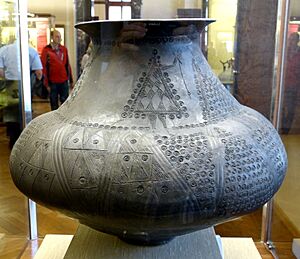
The Iron Age began in the Carpathian Basin around 800 BC. A new group of people moved in and took over the old fortified settlements. These new people might have been ancient Iranian tribes. They were equestrian nomads (people who rode horses) and formed the Mezőcsát culture. They used tools and weapons made of iron. Their rule spread over what is now the Great Hungarian Plain and eastern Transdanubia.
Around 750 BC, people from the Hallstatt culture slowly moved into western Transdanubia. The earlier people still lived there, so both cultures existed side-by-side for centuries. The Hallstatt people used existing forts (like in Velem and Sopron) and built new ones. Important people were buried in special tombs covered by earth. Some of their settlements along the Amber Road became important trading places.
The classic Scythian culture spread across the Great Hungarian Plain between the 600s and 500s BC.
Between 550 and 500 BC, new groups settled along the Tisza river and in Transylvania. This might have been due to military actions by King Darius I of Persia or conflicts between the Cimmerians and Scythians. Those who settled in Transylvania might have been the Agathyrsi, an ancient Thracian tribe. Those in the Great Hungarian Plain might have been the Sigynnae. These new people brought the potter's wheel to the Carpathian Basin and traded a lot with their neighbors.
The Pannonians, an Illyrian tribe, might have moved to southern Transdanubia in the 400s BC.
In the 300s BC, Celtic tribes came to the areas around the Rába river. They defeated the Illyrian people living there. However, the Illyrians influenced the Celts, who adopted their language. In the late 200s BC, Celtic people moving towards the Balkan Peninsula passed through Transdanubia. Some tribes settled there. After 279 BC, the Scordisci (a Celtic tribe) settled where the Sava and Danube rivers meet. They took control of southern Transdanubia. Around that time, the Taurisci (another Celtic tribe) ruled northern Transdanubia. By 230 BC, Celtic people (from the La Tène culture) had slowly taken over the entire Great Hungarian Plain. Between 150 and 100 BC, a new Celtic tribe, the Boii, moved into the Carpathian Basin. They settled in the northern and northeastern parts, mainly in today's Slovakia.
-
Celtic iron artefacts, La Tène culture
-
Remains of a burial mound, 500 BC
Roman Rule in Pannonia
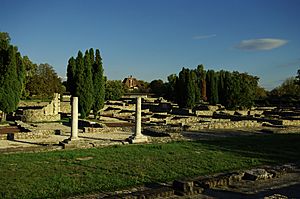
The Romans started their military attacks in the Carpathian Basin in 156 BC. They attacked the Scordisci tribe in Transdanubia. In 119 BC, they marched against Siscia (today's Sisak in Croatia) and strengthened their control over the future Roman province of Illyricum. By 88 BC, the Romans defeated the Scordisci. The Pannonians then moved to northern Transdanubia.
Around 50 BC, the Celtic tribes in the area faced Burebista, a powerful king of the Dacians. He began to expand his kingdom, which was centered in Transylvania. Burebista defeated the Taurisci and Anarti tribes. He also fought against the Celtic tribes led by the Boii. Burebista's victory broke up the Celtic alliance and led to Dacian settlements in southern Slovakia. However, Burebista was later killed, and his kingdom was divided.
Between 15 BC and 9 AD, the Pannonians often rebelled against the growing power of the Roman Empire. But the Romans eventually took control of the rebellious tribes. They organized the conquered land into a new province.
Pannonia Province
The Roman Empire took control of the Pannonians, Dacians, Celts, and other peoples in this area. The land west of the Danube river was conquered by the Romans between 35 and 9 BC. It became a Roman province called Pannonia. The eastern parts of modern-day Hungary later became the Roman province of Dacia (from 106 AD to 271 AD).
The area between the Danube and Tisza rivers was home to the Sarmatian Iazyges tribe from the 1st to 4th centuries AD. Roman Emperor Trajan even officially allowed the Iazyges to settle there as allies. The remaining land was held by Thracian (Dacian) tribes. Also, the Vandals settled on the upper Tisza in the late 100s AD.
For the first 160 years of Roman rule, the local people in Pannonia didn't show many signs of adopting Roman culture.
The four centuries of Roman rule brought a rich and advanced civilization. Many important cities in Hungary today were founded during this time. These include Aquincum (Budapest), Sopianae (Pécs), Arrabona (Győr), Solva (Esztergom), Savaria (Szombathely), and Scarbantia (Sopron). Christianity spread in Pannonia in the 300s, becoming the empire's official religion.
The Age of Migrations
In 375 AD, the nomadic Huns began moving into Europe from the eastern steppes. This started the Great Age of Migrations. By 380 AD, the Huns had entered present-day Hungary. They remained a major power in the region well into the 400s.
Around the same time (379-395 AD), the Roman Empire allowed groups of Goths, Alans, Huns, Marcomanni, and Quadi to settle in Pannonia. Pannonia was still Roman territory then. However, the Visigoths, Alans, Vandals, and most of the Quadi and Marcomanni left this area around 400 AD. They moved on to western and southern Europe.
Pannonia suffered greatly during the Migration Period from 379 AD onwards. The settlement of Goth-Alan-Hun allies caused many crises and destruction. People at the time described it as being under constant attack. Pannonia became a pathway for invasions from both the north and south. Romans began to leave and move away after two difficult decades, starting in 401 AD. This also caused a decline in daily life and Christian communities.
Hun control slowly grew over Pannonia from 410 AD. Finally, the Roman Empire officially gave Pannonia to the Huns by treaty in 433 AD. Romans continued to leave Pannonia until the Avars arrived. Some historians believe the biggest Roman emigration happened early on.
The Huns, taking advantage of other tribes leaving, built a large empire in 423 AD, based in Hungary. In 453 AD, they reached their greatest power under the famous conqueror, Attila the Hun. But the empire fell apart in 455 AD. The Huns were defeated by neighboring Germanic tribes like the Quadi, Gepidi, and Sciri.
The Gepidi tribe (who had lived east of the upper Tisza river since 260 AD) then moved into the eastern Carpathian Basin in 455 AD. They were defeated in 567 AD by the Lombards and Avars and ceased to exist as a separate group.
The Germanic Ostrogoths lived in Pannonia with Rome's permission between 456 and 471 AD.
After the Romans
Roman influence in Pannonia had already started to fade when the Huns arrived in the 300s AD.
It's hard to tell if rebuilt churches were used by barbarians or by Romans who stayed behind. The use of Christian buildings after the 300s doesn't prove that Roman Christian communities survived. This is because Goths and other groups were Arian Christians and might have used the damaged churches. However, some finds, like a gold pin with the name BONOSA, suggest that some Romans did stay. There are stories of Romans who remained in the 400s. For example, Saint Anthony the Hermit was born in Pannonia. The Lombards also took Romans with them to Italy. The last group of Romans to leave were the Syrmians, who moved to the Croatian coast in the early 600s.
Later, Christian groups who moved to the northern part of Lake Balaton created the Keszthely culture. This culture disappeared by the mid-600s.
The first Slavs came to the region, likely from the north, soon after the Ostrogoths left (471 AD). They came with the Lombards and Herulis. Around 530 AD, the Germanic Lombards settled in Pannonia. They had to fight against the Gepidi and the Slavs. In 568 AD, the Avars pushed them out, and they moved into northern Italy.
The nomadic Avars arrived from Asia in the 560s. They completely destroyed the Gepidi in the east and drove away the Lombards in the west. They also took control of the Slavs, partly mixing with them. The Avars built a large empire, much like the Huns had done earlier. This empire was destroyed around 800 AD by attacks from the Franks and Bulgars, and also by internal fights. However, many Avar people remained until the Hungarian tribes arrived.
From 800 AD, the entire Pannonian Basin was controlled by two powers: East Francia and the First Bulgarian Empire. Around 800 AD, northeastern Hungary became part of the Slavic Principality of Nitra. This then became part of Great Moravia in 833 AD.
Also, after 800 AD, southeastern Hungary was conquered by Bulgaria. Western Hungary (Pannonia) paid taxes to the Franks. In 839 AD, the Slavic Balaton Principality was founded in southwestern Hungary, under Frankish rule. During the time of Svatopluk I, northwestern Hungary was conquered by Great Moravia. Pannonia remained under Frankish control until the Hungarian tribes arrived.
See also
 In Spanish: Historia de Hungría antes de la conquista húngara para niños
In Spanish: Historia de Hungría antes de la conquista húngara para niños
- History of Hungary
- Hungarian prehistory
- Seuso Treasure


